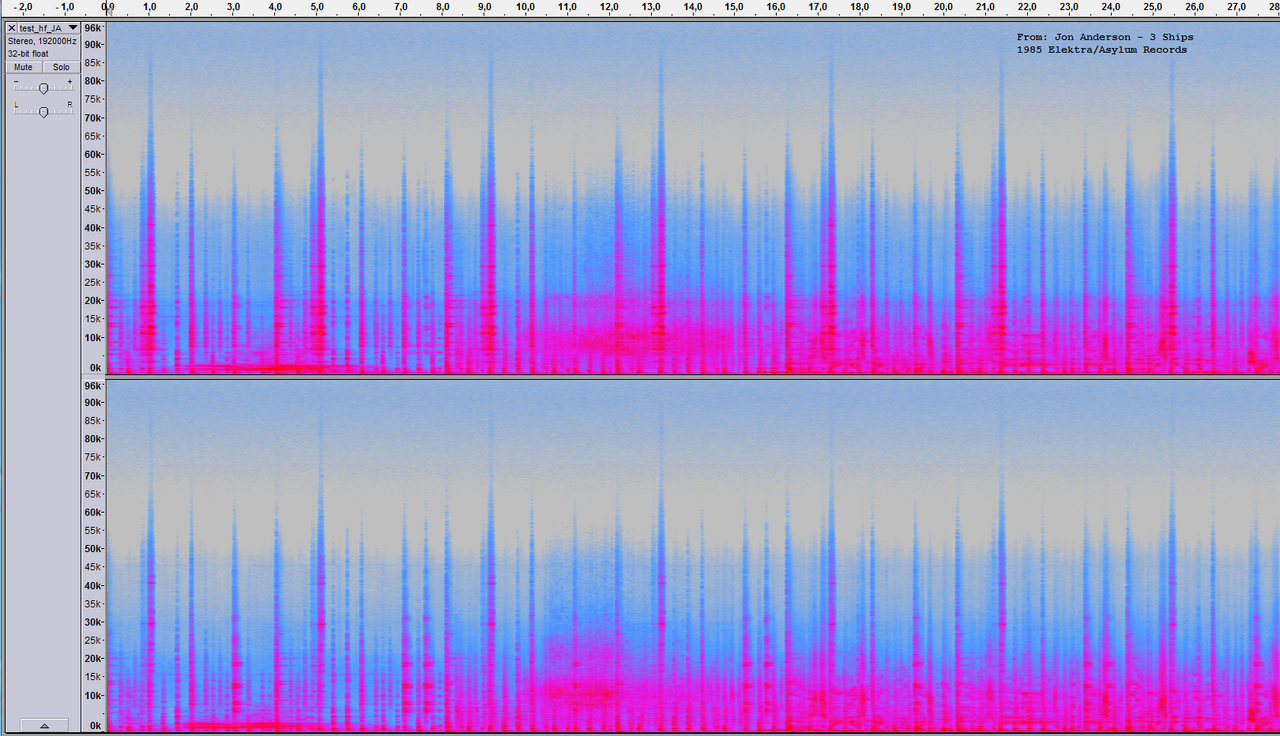analogsurviver
Headphoneus Supremus
- Joined
- Jul 2, 2012
- Posts
- 4,480
- Likes
- 371
@analogsurviver
Using your quoted:
Klangbeispiel 67 - Lyra Etna ( cartridge ) playing "How Deep is the Ocean" track.
What is your explanation for the hereunder?

The lack of recorded information on the record. It can be either/or :
1.) No > 20 kHz content on the - CAUTION, now I AM making a new terminology !!! -
INITIAL recording ( as master can mean soooo maaany things to different people )
( Definition: initial recording is the very first recording made from the microphone feed - no EQ, no compression, no band limitting, no absolutely nothing done to the mike feed, recorded in the best techology available at the time of recording )
2.) Real time transfer to the analogue master from this INITIAL recording
Real time cutting of analogue record master is limited to approx 27 kHz ( depending on the cutting equipment ) - and, as the power required to cut the high frequencies accurately IS enormous ( peak capability of top cutter heads is 400-500 W per channel - meaning a cymbal crash may well require a whole kW of electrical power to engrave the unlimited/uncompressed signal ), engineers tend to limit/compress/ both dynamic and frequency range in the treble - for understandable fear of burning the cutter head's coil(s). Given that all cutter head maintenance/repairs are today handled no longer by the original manufacturers but - at best - former employees of said manufacturers with sufficient knowledge, experience ( and , sadly, young enouh to still be able to work... ) and there are no NOS cutter heads available anywhere, that fear is certainly justifiable. Burning the recording head can put one out of bussiness for months - such is the turnaround for cutter heads these days.
3. Half speed mastering can put signals on analogue master disc up to approx 54 kHz - and requires only 1/4th of the power required for real time cutting, obviously not posing any danger to burn the cutter head, but takes twice as time long to complete. This, obviously, has the potential to place on disc whatever a 96/24 PCM digital recording can record ( frequency wise, dynamic range on conventional record IS limited ) in the first place. Half speed mastering is problematic in bass - because it absolutely requires 10 Hz at 0 dB capability, something that is VERY hard to achive - and has to be done by modifying, normally no cutting lathe I am aware of has been initially designed for half speed mastering. Late maverick among analogue record mastering engineers, Stan Ricker, in his last years used a compromise - 2/3rd speed mastering, which still is capable of approx 40 kHz high end and low end that does not sound anemic - as some half speed mastered records - his included - can sound.
So, short answer - a decent vintage half speed mastered vinyl record made from a high speed ( minimum 38 cm/s) reel to reel analog initial recording should have been used for the true assesment of the phono cartridge playback capability using real music recordings - as opposed to test discs. The reason why such a record has not been selected for demonstrating ONE OF MANY CARTRIDGES has probably something to do with bussiness - not many sponsors would be willing to allow 30-40 years old records to be shown to clearly outperform their modern day counterparts.
Back then, only truly VERY dedicated recording engineers did use microphones with the sufficient response above 20 kHz - usually by modifiying Bruel & Kjaer measuring microphones and making them compatible with studio gear ( all measuring mics are, basically, single ended ). Sheffield, Miller & Kreisel, Reference Recordings, maybe Crystal Clear, maybe more ... of these, only Reference Recordings were made to analogue tape and ( would have to check ..) may have been transfered to disc using half speed mastering.
There is absolutely no reason why today, with all the knowlede gained and lessons learned from the past, modern INITIAL recordings containing music above 20 kHz could be made - and transferred to analogue record at less than real time speed.
P.S: Your post lacks a vital piece of information : WHEN is this "clip" taken - at which exact time of the sample ? There is no way it is taken during the applause - which DOES, unmistakably, contain frequencies well above 20 kHz - and has, at the same time, in the range above 20 kHz about as large amplitude as practicably any musical instrument . Applause is the most consistent, univerasaly known and available "source" of above 20 kHz "music" - if and when captured correctly.
Last edited:














